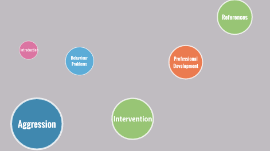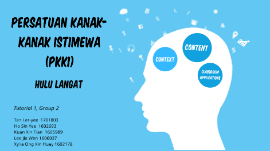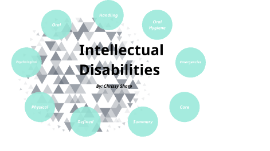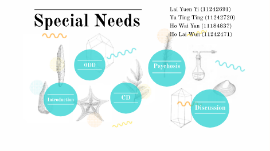Special needs
Transcript: http://en.wikipedia.org/wiki/Least_Restrictive_Environment http://www.teachervision.fen.com/special-education/new-teacher/48460.html http://www.sedl.org/change/issues/issues43/definition_inclusion.html http://www.nimh.nih.gov/health/publications/attention-deficit-hyperactivity-disorder/complete-index.shtml Inclusion and Mainstreaming Special needs refers to kids who require special accommodation in the classroom or other school settings. It could be students with learning disabilities, such as ADHD, or physical disabilities, like blindness. However, it also includes students of higher ability, or "gifted" students, who may require more challenging work to stay engaged. Students with special needs often have trouble learning in the classroom, but not necessarily for the same reasons. It is important to understand why the students struggle in order best accommodate and help the reach their full potential. In this presentation we will explore ways of accommodating ADHD, auditory disability, and learning disability through techniques such as inclusion, mainstreaming, least restrictive environment, and assistive technology. First, let's define the terms: 1. ADHD (Attention deficit hyperactivity disorder)- one of the most common childhood disorders and can continue through adolescence and adulthood. Symptoms include difficulty staying focused and paying attention, difficulty controlling behavior, and hyperactivity (over-activity). 2. Auditory disability- any disorder that henders hearing or auditory processing 3. Learning disability- refers to a variety of disorders that affect the acquisition, retention, understanding, organization or use of verbal and/or non-verbal information. Because of budget cuts and in an effort to improve special needs education, schools have started using inclusion and mainstreaming more and more. Mainstreaming is an older term, sometimes associated primarily with the physical assimilation of students with disabilities with their non-disabled peers. Inclusion is a somewhat more values-oriented term than integration, its legal counterpart. "The true essence of inclusion is based on the premise that all individuals with disabilities have a right to be included in naturally occurring settings and activities with their neighborhood peers, siblings, and friends" (Erwin, 1993, p. 1) Inclusion can be an excellent way on integrating special needs students, and getting them familiar with a "standard" classroom, but it can have its challenges. As teachers, it is our responsibility to do everything in our power to help students learn. One thing we can do is called assistive technology. Refrences Overview Accommodating Special Needs What is Least Restrictive Environment? Assistive Technology What does "Special Needs" mean and how can teachers accomodate? "Assistive technology is any machine, computer, or device that makes it possible or easier for a person with a disability to perform an action or function." Assistive can help engage students who get distracted by adding videos, pictures, audio clips, and hands on activities. P.S.: This video is an example of AT! Some other examples are highlighters, Simon Reading Machines, Audio players, and glasses. Hand-held audio players can be very helpful for students with auditory disabilities, because they can adjust the volume. Simple tools like highlighers can help students with ADHD concentrate on recognizing the most important information. Striving to help all students meet their full potenial

















